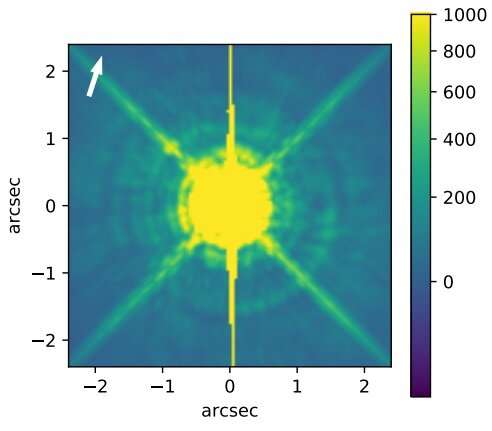January 15, 2020 report
V473 Lyr has a low-mass companion, study suggests

Using ESA's XMM-Newton spacecraft, astronomers have conducted X-ray observations of a peculiar Cepheid variable star known as V473 Lyr. Results of the study suggest that this star has a young, low-mass companion. The finding is detailed in a paper published January 7 on the arXiv pre-print repository.
In general, Cepheid variables (or Cepheids) are luminous, yellow, horizontal branch stars changing their brightness with time as a result of regular stellar pulsations. Given that their periods of variation are closely related to their luminosity, astronomers use them to measure interstellar and intergalactic distances.
Located most likely some 1,800 light years away, V473 Lyr is a peculiar Cepheid with a variable amplitude of pulsation. Its main pulsation period is 1.49 days, with a period of amplitude variation of 1,205 days (over three years). Several studies have been carried out aiming to explain this amplitude variation, and one of them found that V473 Lyr has an X-ray source at the position of the Cepheid.
A team of astronomers led by Nancy Evans of Smithsonian Astrophysical Observatory (SAO) in Cambridge, Massachusetts, decided to take a closer look at the identified X-ray source, hoping to determine its nature and to verify if it is associated with amplitude variation of V473 Lyr. For this purpose, they analyzed the results of new observations of this star made with the X-ray Multi-Mirror Newton (XMM-Newton) telescope.
"We obtained an XMM-Newton observation of this star to follow up a previous detection in X-rays," the astronomers wrote in the paper.
The study shows that the X-ray flux in V473 Lyr, in contradiction to two similar Cepheids (Delta Cephei and Beta Doradus) remained constant for a third of the pulsation cycle covered by the observation. This, according to the researchers, indicates that the X-rays are most probably not produced by the changes around the pulsation cycle, but by a low-mass companion.
Moreover, the X-ray spectrum of V473 Lyr was found to be soft (0.6 keV), with X-ray properties, which is consistent with a young, low-mass companion. The data suggest that it is most likely a young G or K main sequence star, with a separation from the primary estimated to be between 30 and 300 AU. Such objects are rarely found, except in places like open clusters.
The research also emphasized the difficulty of detecting new low-mass companions of Cepheids, and confirms the status of V473 Lyr as a Cepheid, though an unusual one.
"Low-mass companions of Cepheids are difficult to identify, since the spectral energy distribution is similar to that of the Cepheid, and the companion is much fainter than the Cepheid. (...) The X-ray active companion is another confirmation that V473 Lyr is a young Pop I star itself, despite its unusual pulsation characteristics," the authors of the paper concluded.
More information: X-ray Observations of the Peculiar Cepheid V473 Lyr Identify A Low-Mass Companion, arXiv:2001.02253 [astro-ph.SR] arxiv.org/abs/2001.02253
© 2020 Science X Network





















